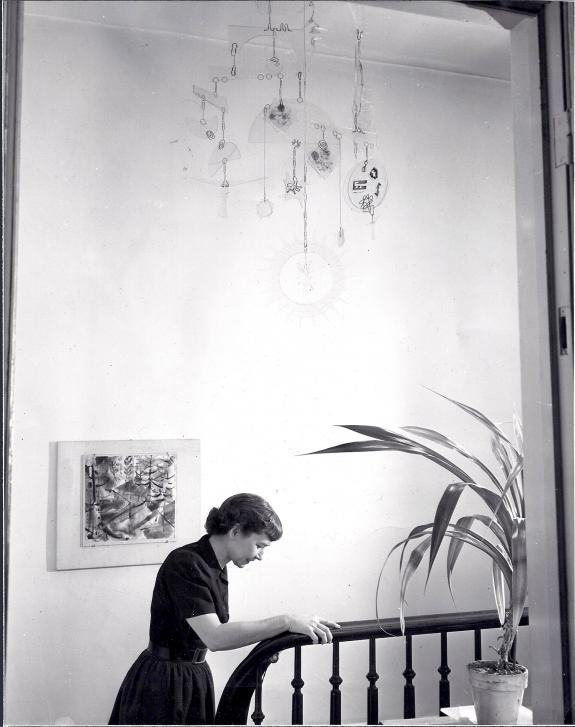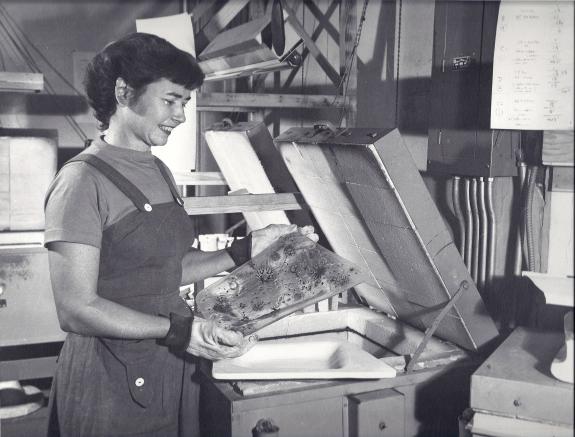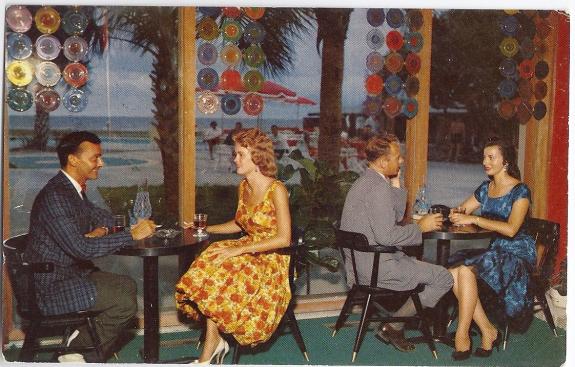Founded in 1948 by Michael and Frances Higgins, the innovative and bold designs of Higgins Glass are still being produced in their Chicago studio. By the midcentury, the ancient art of glass fusing had gone by the wayside and was mostly replaced with the much less labor-intensive style of glass blowing. By reviving and refining the intricate process of fusing, Michael and Frances created vibrant and beautiful pieces using techniques still closely followed in their studio today.

The Early Years
Higgins Glass was originally operated out of the couple’s Chicago apartment, using a kiln behind the sofa.
“Everyday items, such as bowls and plates, were transformed, through an arresting mix of geometric and curved lines, and bold use of color, into objects still useful, yet also visually vibrant and exciting,” the company states regarding the couple’s early work. A partnership with Dearborn Glass in 1957 brought Higgins Glass to a new working space and provided national exposure, especially to the “Higginsware” line—where the still-popular Rondelays began.
Returning to a private studio in 1966, Michael and Francis set up shop in Riverside, Illinois where the studio still operates today. With the passing of Michael in 1999 and Francis in 2004, their work lives on through the mother and son team of Louise and Jonathan Wimmer. Louise joined the Higgins team in 1978 while Jonathan remembers walking over to the studio from his nearby preschool and playing with clay.
“I kind of just grew up in the studio, Frances and Michael were like grandparents to me. Around 8th grade, I started apprenticing with Michael,” remembers Jonathan. Starting with the basics of cutting, Jonathan was immersed in the different techniques and skills of glass fusing. “Michael took me under his wing because we were the only males. We had quite a bond,” Jonathan continues. Michael would often design a piece and ask Jonathan to complete the finishing using Higgins’ trusted tools and techniques.
Made In-House
Making their own glass, a practice started out of necessity in the beginning, is a tradition still in use today. “The glass that we use is more like a window glass, it’s very durable… I mix the colors here and then send it to Indiana, then they produce the glass that we then cut down,” explains Jonathan. “It makes us a lot more unique because no one else does the type of work that we do, the way that we do it,” he continues.

MCM Influences
The eye-catching glass pieces, with their vibrant colors and crisp yet curved lines, are without a doubt an “exclamation to your decorating scheme” as advertised in the late 1950s. “When you look at our iconic Rondelays and mobiles, it just has that pop of midcentury. Even if you don’t have a large set of Rondelays, if you put that in a room it just adds so much depth,” says Jonathan.
Having an architect as a father, Jonathan was influenced by Midcentury Modern style at an early age. “I grew up in a house with Bertoia chairs and Knoll couches and all the wonderful artwork around our home. It’s something that when you grow up in it, it just sticks with you. Hearing Francis and Michael, they were huge Midcentury Modern enthusiasts,” says Jonathan.

Continuing The Legacy
The Higgins line today has seamlessly blended fresh new ideas into the classic designs that have been loved for decades. “The fact that we worked underneath them so much, no matter what we do, we are always going to have a twinge of Fran and Michael… you can’t help but be inspired by them when you’re here because they’re all around you,” says Jonathan.
Higgins Glass Today
Looking forward, Jonathan hopes to work with interior designers and collaborate on larger projects. “I would love for people to come in with an idea. I love the process of ‘maybe this won’t work, but we could try something else’,” explains Michael.
Still located in their Riverside studio, Higgins Glass is accessible for shoppers throughout the week and also hosts an annual Holiday Open House that serves as a kick-off to the holiday season.
For more, visit Higgins Glass.











